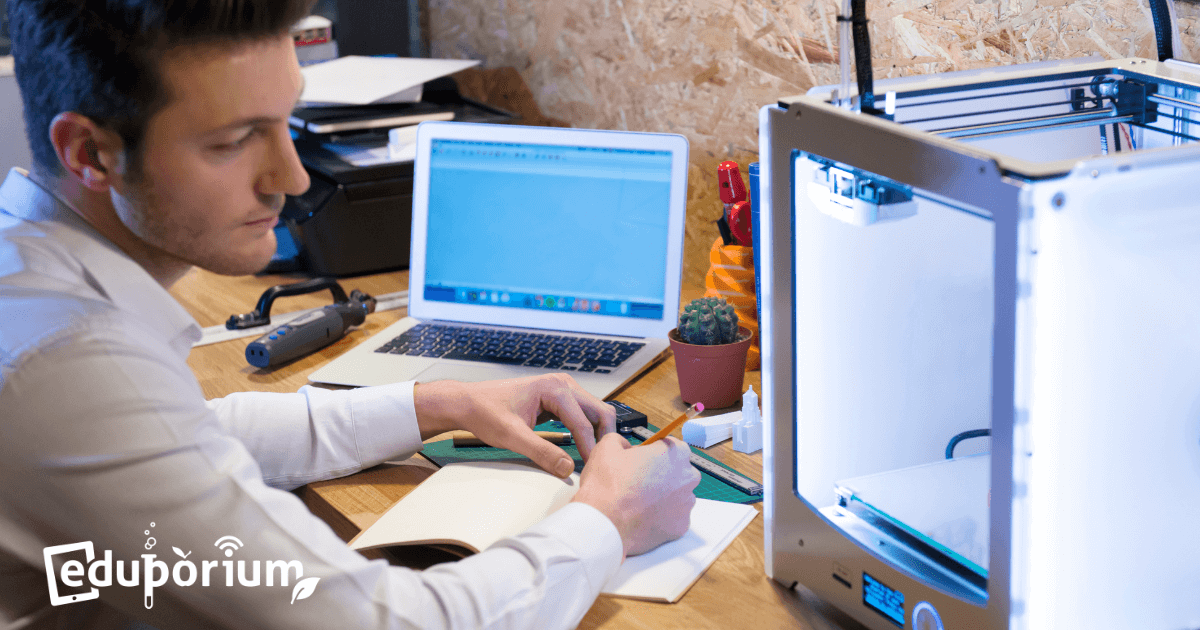Erin Piazza is the Library Media Specialist at Watertown High School in Watertown, MA. Tasked with expanding the possibilities of her students’ 21st century education, Erin set out to turn her traditional, bookshelf-filled library into an innovative makerspace for her students to explore, craft and learn through hands-on activity! Immediately when you walk into her library, you notice the row of three 3D printers with a group of engaged high school kids huddled around them—well after the final bell had rang. So, how did she do it?
1) Please pick a (relatively small) project that is part of your work, and describe it. What are the various components of the project?
The project was transforming a large portion of our high school’s library into an interactive environment, or what is commonly referred to as a makerspace. It was actually more of a physical project as we spent a long time removing the old bookshelves that lined the entire wall of where our space is now. Once we cleared it all out and actually made the space available, we began replacing the old books with brand new technologies for our kids to use. I really had to manage this process—determine what to keep and what to let go so that I could guarantee that the kids would have access to useful books and catalogs rather than outdated ones. Newer technologies are replacing certain types of books, so replacing them gave us a lot more space for newer things. So, even though I didn’t use a bunch of high-tech construction equipment throughout the building process, I was real excited to be able to create the space where a lot of high-tech learning products would be done and be able to manage the books coming in and out.
2) What are the necessary skills to fulfill these parts of the project? Please describe skills relevant to your project, even if these are not acquired by academic study.
Certainly relying on my experience as an educator was pretty important in determining what books to keep and what to get rid of. Knowing what materials would be helpful for certain classes and what’s good to have around for general interest were two factors I considered. I consulted a lot of different places, like, for instance, there are different manuals that you can sort of follow to help give you guidelines, but, again, it was a lot of I guess you would say instinct in selecting the materials.
3) What technology do you use to complete each part of the project, if any?
Well, a lot of it was manual—just going book by book, but then I also used an electronic catalog to look up statistics on how much certain books had been used in recent years. I also just consulted which general digital versions might be available. So, if we have a science database that’s updated every day, maybe we shouldn’t have a 10-year-old science book laying on the shelf. Students are able to find much better information using the educational database online. That was definitely one tech-heavy area of the project—the research.
4) What technology do you use in order to train the various skills that you need for the project?
Well, for me, what I basically did was trial and error in nature. Seeing what technology has worked well in school helped me to decide what I should bring into the makerspace. I went to school for library science and there actually is a lot of information in different manuals that will help you out quite a bit. It’s kind of knowing where to look and that, again, comes with experience.
5) What background information helps you engage in and complete the project better?
Knowledge, I would say, of the curriculum in different subject areas—state and district frameworks—definitely helped us and also waiting a full school year to see what projects students were going to be wanting to do. This gave me an idea of what kind of equipment to invest in and we ultimately decided to get the three 3D printers, which we’re pretty happy with.
6) What is the most difficult part of your project?
I guess it was the ongoing nature of it. We cleared out 11 tall shelves and I realized I wasn’t going to have room for some of the newer stuff if I didn’t get rid of some things. It took a while, so patience was definitely needed, but it was definitely worth it in the end. Our new makerspace—the Fab Lab—is our space to use technology to explore other things that are no longer found on dusty bookshelves. It’s been really fun so far this school year with different classes coming up to use the machines and I’ve even gotten involved a little bit with some of their projects, so it’s been a really good experience in a really high-energy space for us so far. It was a project that I didn’t expect would take so much of my time, but it was pretty fun in a lot of ways because it allowed us to do more interesting things with the space and gave me a better sense of what we did have versus what we should have. It was definitely fun!



